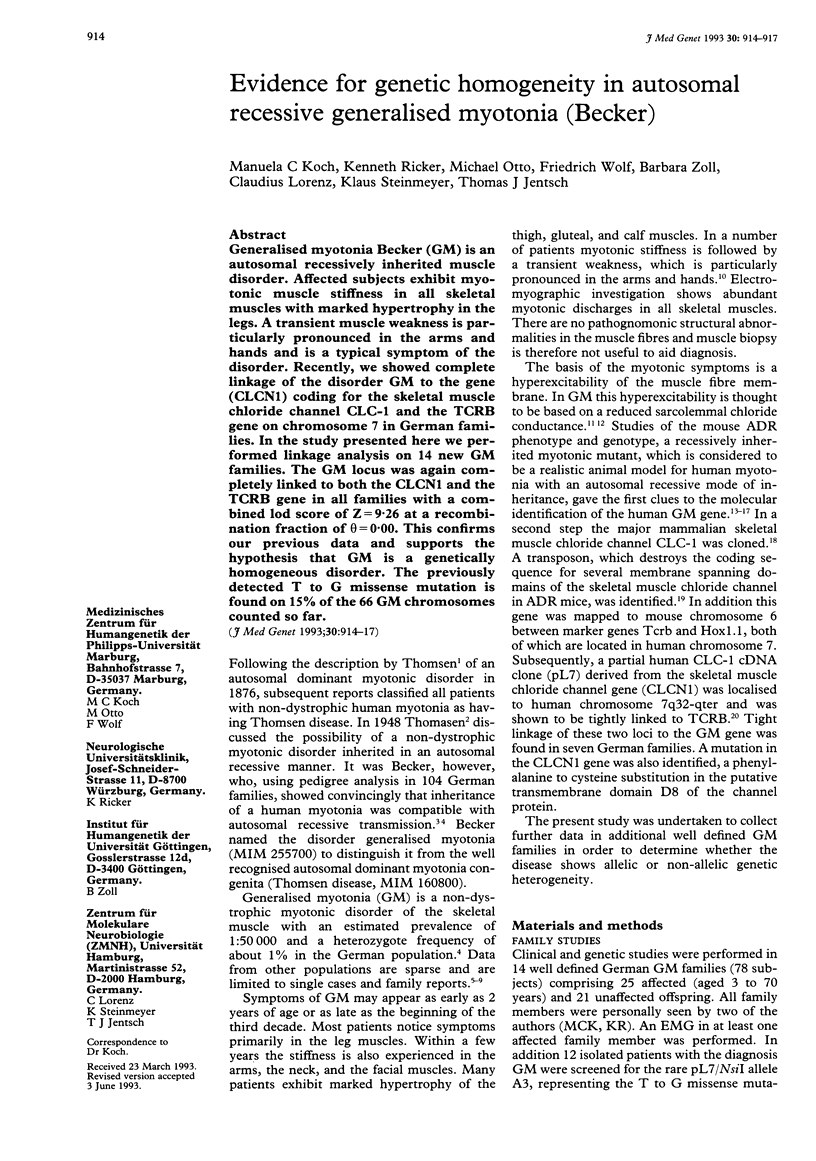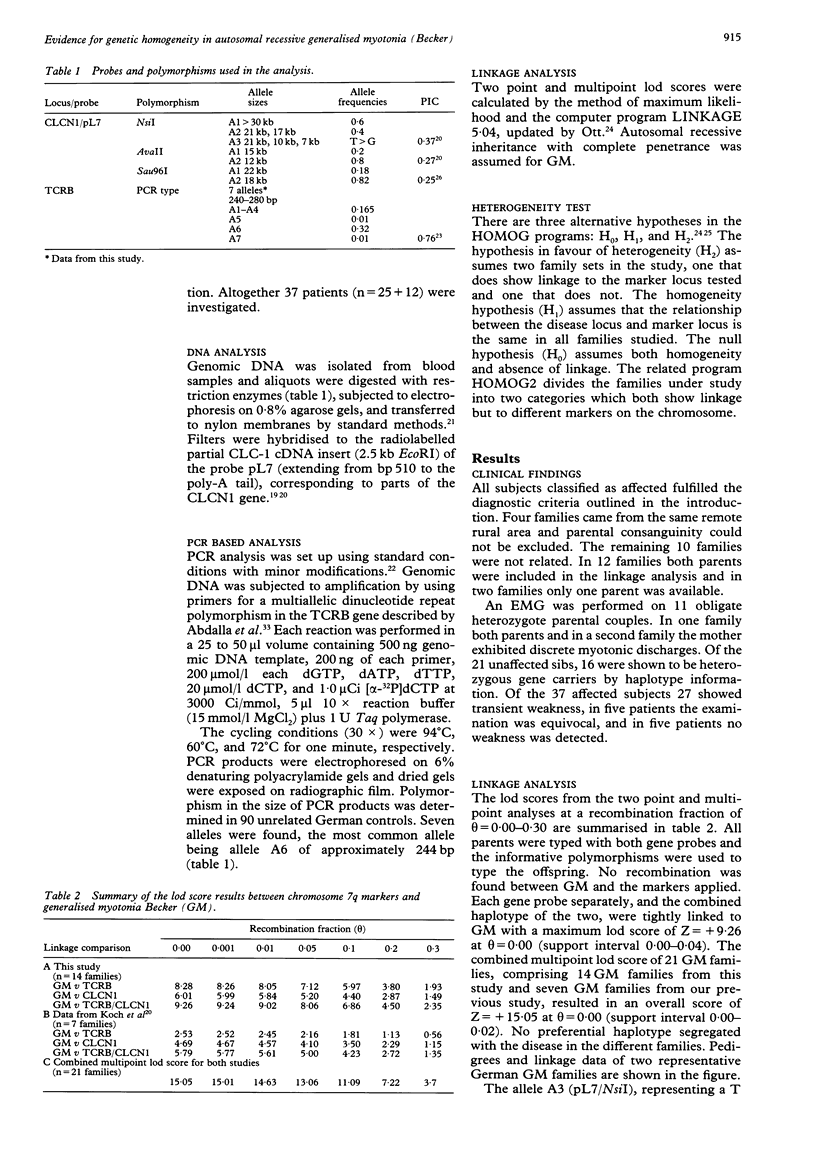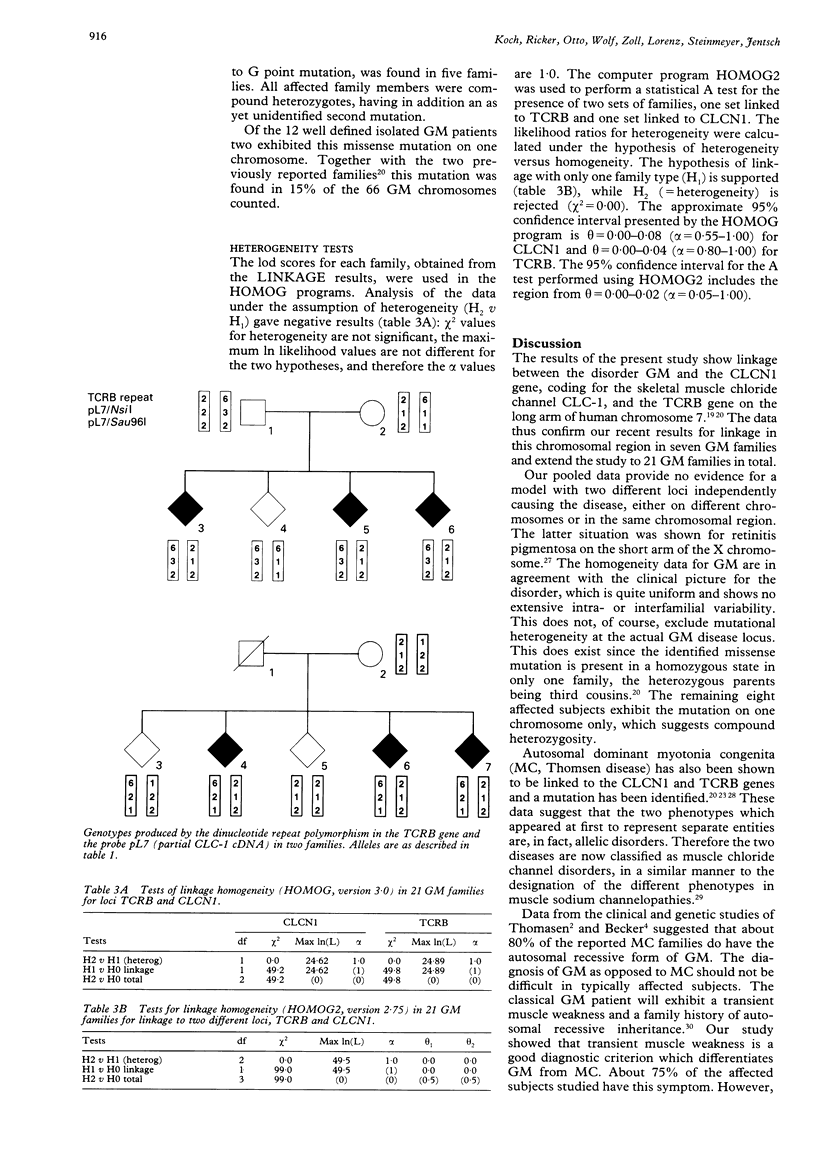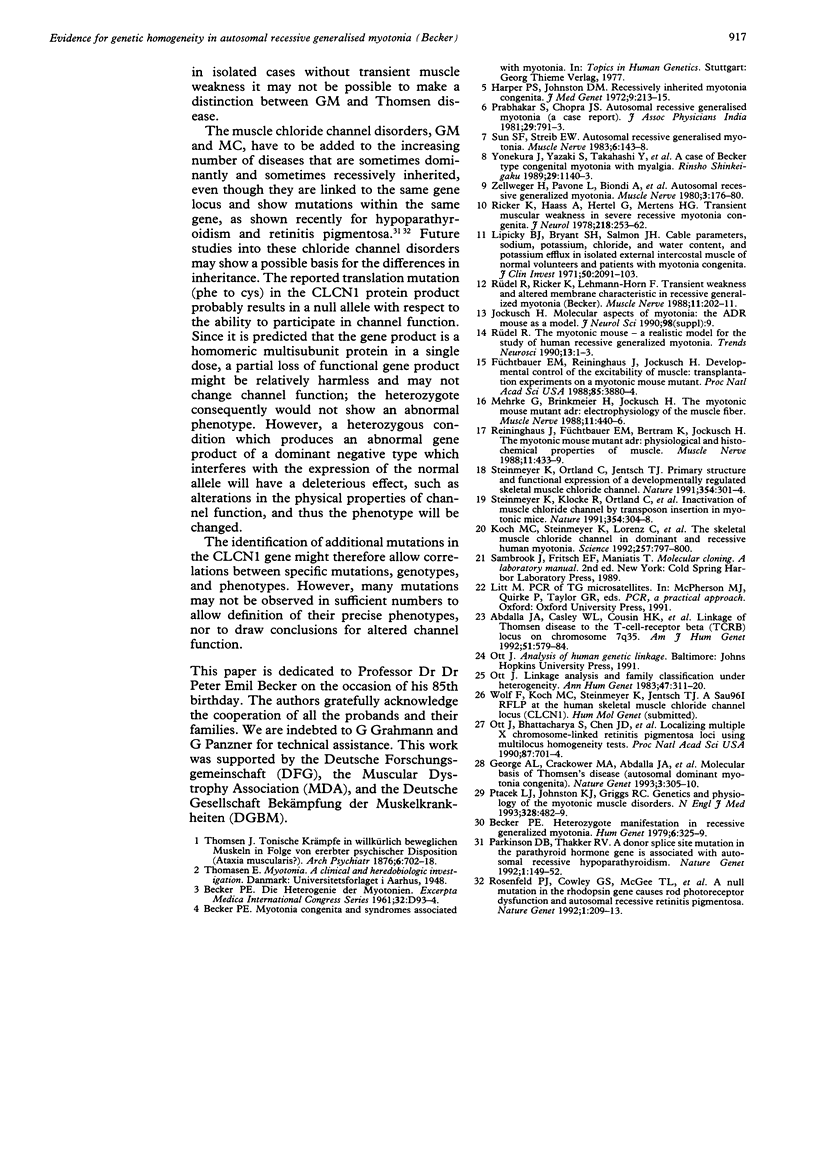Abstract
Generalised myotonia Becker (GM) is an autosomal recessively inherited muscle disorder. Affected subjects exhibit myotonic muscle stiffness in all skeletal muscles with marked hypertrophy in the legs. A transient muscle weakness is particularly pronounced in the arms and hands and is a typical symptom of the disorder. Recently, we showed complete linkage of the disorder GM to the gene (CLCN1) coding for the skeletal muscle chloride channel CLC-1 and the TCRB gene on chromosome 7 in German families. In the study presented here we performed linkage analysis on 14 new GM families. The GM locus was again completely linked to both the CLCN1 and the TCRB gene in all families with a combined lod score of Z = 9.26 at a recombination fraction of theta = 0.00. This confirms our previous data and supports the hypothesis that GM is a genetically homogeneous disorder. The previously detected T to G missense mutation is found on 15% of the 66 GM chromosomes counted so far.
Full text
PDF



Selected References
These references are in PubMed. This may not be the complete list of references from this article.
- Abdalla J. A., Casley W. L., Cousin H. K., Hudson A. J., Murphy E. G., Cornélis F. C., Hashimoto L., Ebers G. C. Linkage of Thomsen disease to the T-cell-receptor beta (TCRB) locus on chromosome 7q35. Am J Hum Genet. 1992 Sep;51(3):579–584. [PMC free article] [PubMed] [Google Scholar]
- Becker P. E. Heterozygote manifestation in recessive generalized myotonia. Hum Genet. 1979 Feb 15;46(3):325–329. doi: 10.1007/BF00273316. [DOI] [PubMed] [Google Scholar]
- Füchtbauer E. M., Reininghaus J., Jockusch H. Developmental control of the excitability of muscle: transplantation experiments on a myotonic mouse mutant. Proc Natl Acad Sci U S A. 1988 Jun;85(11):3880–3884. doi: 10.1073/pnas.85.11.3880. [DOI] [PMC free article] [PubMed] [Google Scholar]
- George A. L., Jr, Crackower M. A., Abdalla J. A., Hudson A. J., Ebers G. C. Molecular basis of Thomsen's disease (autosomal dominant myotonia congenita). Nat Genet. 1993 Apr;3(4):305–310. doi: 10.1038/ng0493-305. [DOI] [PubMed] [Google Scholar]
- Harper P. S., Johnston D. M. Recessively inherited myotonia congenita. J Med Genet. 1972 Jun;9(2):213–215. doi: 10.1136/jmg.9.2.213. [DOI] [PMC free article] [PubMed] [Google Scholar]
- Koch M. C., Steinmeyer K., Lorenz C., Ricker K., Wolf F., Otto M., Zoll B., Lehmann-Horn F., Grzeschik K. H., Jentsch T. J. The skeletal muscle chloride channel in dominant and recessive human myotonia. Science. 1992 Aug 7;257(5071):797–800. doi: 10.1126/science.1379744. [DOI] [PubMed] [Google Scholar]
- Lipicky R. J., Bryant S. H., Salmon J. H. Cable parameters, sodium, potassium, chloride, and water content, and potassium efflux in isolated external intercostal muscle of normal volunteers and patients with myotonia congenita. J Clin Invest. 1971 Oct;50(10):2091–2103. doi: 10.1172/JCI106703. [DOI] [PMC free article] [PubMed] [Google Scholar]
- Mehrke G., Brinkmeier H., Jockusch H. The myotonic mouse mutant ADR: electrophysiology of the muscle fiber. Muscle Nerve. 1988 May;11(5):440–446. doi: 10.1002/mus.880110505. [DOI] [PubMed] [Google Scholar]
- Ott J., Bhattacharya S., Chen J. D., Denton M. J., Donald J., Dubay C., Farrar G. J., Fishman G. A., Frey D., Gal A. Localizing multiple X chromosome-linked retinitis pigmentosa loci using multilocus homogeneity tests. Proc Natl Acad Sci U S A. 1990 Jan;87(2):701–704. doi: 10.1073/pnas.87.2.701. [DOI] [PMC free article] [PubMed] [Google Scholar]
- Parkinson D. B., Thakker R. V. A donor splice site mutation in the parathyroid hormone gene is associated with autosomal recessive hypoparathyroidism. Nat Genet. 1992 May;1(2):149–152. doi: 10.1038/ng0592-149. [DOI] [PubMed] [Google Scholar]
- Prabhakar S., Chopra J. S. Autosomal recessive generalised myotonia. (A case report). J Assoc Physicians India. 1981 Sep;29(9):791–793. [PubMed] [Google Scholar]
- Ptacek L. J., Johnson K. J., Griggs R. C. Genetics and physiology of the myotonic muscle disorders. N Engl J Med. 1993 Feb 18;328(7):482–489. doi: 10.1056/NEJM199302183280707. [DOI] [PubMed] [Google Scholar]
- Reininghaus J., Füchtbauer E. M., Bertram K., Jockusch H. The myotonic mouse mutant ADR: physiological and histochemical properties of muscle. Muscle Nerve. 1988 May;11(5):433–439. doi: 10.1002/mus.880110504. [DOI] [PubMed] [Google Scholar]
- Ricker K., Haass A., Hertel G., Mertens H. G. Transient muscular weakness in severe recessive myotonia congenita. Improvement of isometric muscle force by drugs relieving myotomic stiffness. J Neurol. 1978 Aug 25;218(4):253–262. doi: 10.1007/BF00312881. [DOI] [PubMed] [Google Scholar]
- Rosenfeld P. J., Cowley G. S., McGee T. L., Sandberg M. A., Berson E. L., Dryja T. P. A null mutation in the rhodopsin gene causes rod photoreceptor dysfunction and autosomal recessive retinitis pigmentosa. Nat Genet. 1992 Jun;1(3):209–213. doi: 10.1038/ng0692-209. [DOI] [PubMed] [Google Scholar]
- Rüdel R., Ricker K., Lehmann-Horn F. Transient weakness and altered membrane characteristic in recessive generalized myotonia (Becker). Muscle Nerve. 1988 Mar;11(3):202–211. doi: 10.1002/mus.880110303. [DOI] [PubMed] [Google Scholar]
- Rüdel R. The myotonic mouse--a realistic model for the study of human recessive generalized myotonia. Trends Neurosci. 1990 Jan;13(1):1–3. doi: 10.1016/0166-2236(90)90049-g. [DOI] [PubMed] [Google Scholar]
- Steinmeyer K., Klocke R., Ortland C., Gronemeier M., Jockusch H., Gründer S., Jentsch T. J. Inactivation of muscle chloride channel by transposon insertion in myotonic mice. Nature. 1991 Nov 28;354(6351):304–308. doi: 10.1038/354304a0. [DOI] [PubMed] [Google Scholar]
- Steinmeyer K., Ortland C., Jentsch T. J. Primary structure and functional expression of a developmentally regulated skeletal muscle chloride channel. Nature. 1991 Nov 28;354(6351):301–304. doi: 10.1038/354301a0. [DOI] [PubMed] [Google Scholar]
- Sun S. F., Streib E. W. Autosomal recessive generalized myotonia. Muscle Nerve. 1983 Feb;6(2):143–148. doi: 10.1002/mus.880060210. [DOI] [PubMed] [Google Scholar]
- Yonekura J., Yazaki S., Takahashi Y., Someya K., Tadokoro M. [A case of Becker type congenital myotonia with myalgia]. Rinsho Shinkeigaku. 1989 Sep;29(9):1140–1143. [PubMed] [Google Scholar]
- Zellweger H., Pavone L., Biondi A., Cimino V., Gullotta F., Hart M., Ionasescu V., Mollica F., Schieken R. Autosomal recessive generalized myotonia. Muscle Nerve. 1980 Mar-Apr;3(2):176–180. doi: 10.1002/mus.880030212. [DOI] [PubMed] [Google Scholar]


